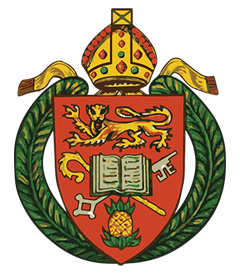Archbishop’s Christmas Message 2023
Christmas – An Affirmation of Hope
It cannot escape our attention that as Christmas 2023 approaches, there is an unprecedented level of carnage and death of thousands of innocent children in the War being conducted in Gaza. Earlier this year, we also witnessed similar acts of violence, kidnapping and death directed against children in the war between Russia and Ukraine. These are the most newsworthy of the wars currently being fought across the world, but more wars are going on simultaneously with the consequent displacement, migration and death impacting the lives of children and adults at levels the world has never known.
The tragedy is that the “civilized world” looks on in silence, even as the war chest and the expenditures on military equipment and military technology are advancing by trillions of dollars. Even more tragic is the fact that sections of the Christian community find within their understanding of the faith the imperative to stand behind these wars as acts of divine ordaining and avenues to peace.
How can we celebrate Christmas with themes of joy, happiness and peace in such a context? We need to remind ourselves that the Christmas story contains themes of light and darkness, and what we are witnessing in our world are manifestations of darkness. In our national context today, it speaks of poverty, crime, violence, and death, domestic violence, injustice, and social and economic inequalities.
On the international scene, darkness is evident as we witness and remain silent while thousands of homes are destroyed in a world in which many are homeless or live in sub-human conditions; and hospitals are destroyed in a world in which millions lack basic health care, even in the most developed countries; and the infrastructure of nations which was constructed over decades and centuries is being destroyed with no prospect of these being rebuilt by the agents of destruction.
Images of Darkness and Light
The truth is that images and experiences of darkness have never been absent from human history, and in particular, among people of the Judeo-Christian tradition. Indeed, it is present in the Christmas story which we celebrate at this time. The good news is that while the image of darkness is very real, it is only by the presence of the contrasting image of light that we can find our way through and beyond its boundaries.
The Christmas story is not a standalone event that happened at a point in time. Its origins are in the tradition and experience of the people of God and the fulfillment of the longing and hope of a people who trust in the compassion, justice, and saving intention of God for all of humanity as the source of light to the world. This is particularly significant as this expression of divine intent demonstrates a God who is the beginning and the end, a God who creates and who will redeem, and whatever the evidence to the contrary, a God who will gather up every loose end. Nothing will be lost; nothing will be meaningless.
In contrast, the current state of global humanitarian expression, or lack thereof, speaks to a world and future in which there is no endgame in sight that can offer a ray of light, justice, equality, and hope for humanity.
One of the Old Testament readings for Christmas Day is from Isaiah 9:2-7 which is grounded in the life of a people whose experience reflected contrasting images of light and darkness. Let me quote selected verses from that reading:
The people who walked in darkness
have seen a great light;
those who lived in a land of deep darkness—
on them light has shined.
For a child has been born for us,
a son given to us;
authority rests upon his shoulders;
and he is named
Wonderful Counselor, Mighty God,
Everlasting Father, Prince of Peace.
His authority shall grow continually,
and there shall be endless peace
for the throne of David and his kingdom.
He will establish and uphold it
with justice and with righteousness
from this time onward and forevermore.
The zeal of the Lord of hosts will do this.
Isaiah prophesied to people who were caught in deep fear as Assyria had become the dominant power and was systematically taking control of the region. It seems incredible that in the context of the military threat that these people faced, the birth of a baby could be a source of assurance.
As we observe Christmas this year as a nation and as a community of faith, many do so without any sense of anticipation and excitement. Many people feel hopelessness and despair about life in our nation and the prospects for the future.
Others see Christmas as a little escape from the harsh realities of life. Yet, if you leave behind for a moment our contemporary challenges and Christmas and go back to the story of the first Christmas, you will see that it contains similar themes of despair, suffering, pain, isolation, rejection, and abandonment, and the most lowly of human circumstances.
Luke 2:1-14 sets out for us the event which is at the heart of our celebration of Christmas. Joseph and Mary, expectant parents, like any normal parents-to-be, have wonderful plans for the birth of their child, but find instead, that they are relegated to the place with the animals. Does this not sound like the conditions under which pregnant women are giving birth in Gaza today?
With all of the hardship, gloom and anguish, there is cause for celebration as new life breaks forth, and we are then introduced to the central figure of Christmas, the baby Jesus. At the heart of Christmas stands an infant who from his birth was treated as an outsider, excluded, and on the fringe. It was an infant who from the outset faced the evil and the murderous intention of Herod.
The infant is always a symbol of the vulnerable and the weak in society and yet, it is through a helpless babe that God chose to reveal his presence and activity on behalf of his distressed and oppressed people.
In a world in which military, economic, technological and social power rule, we must remind ourselves that our God did not have to match Pharaoh, Nebuchadnezzar, or Herod and their military and political power to win the day. Neither will our God need to match or defeat the powers of darkness of our time with anything other than the light which comes from the birth of a seemingly vulnerable baby.
Perhaps, we may consider the fact that our Lord continues to come to us in the faces, the smiles, the innocence, the cries, or even the screams of the vulnerable infants and children we see on our television each day, and all the children who are victims of violence in our world.
The Christmas story in Luke includes the shepherds as primary actors. They were numbered among the poor in that era, barely eking out an existence from animal husbandry, which was their livelihood. Yet, it was the poor, symbolized by these shepherds, who heard the message of the fulfillment of centuries of human longing and hope in the birth of Jesus.
The Incarnation and Its Significance
In the Incarnation, God took the initiative to subject Himself to the conditions of mortal life and to take violence, suffering, and evil onto Himself, even to the point of the Cross, thereby opening up a channel for humanity’s relationship with Him and with implications for the eternal future. Through the Incarnation, therefore, God shows himself as a God of the abandoned, the rejected, the downtrodden and the despairing, and is present wherever men and women experience themselves and their situation as one of darkness.
Christmas then, is not about the celebration of a trouble-free world but, even in this world of violence, suffering, challenges and depression, it is an affirmation of the hope which is ours because of the Incarnation which took place in the birth of Jesus.
One of the popular Christmas hymns captures for us the profound significance of what happened on that first Christmas as announced by the angels in the words, “The hopes and fears of all the years are met in thee tonight.”
So this Christmas as we recall the birth of the child Jesus, may we see in a new way in the face of our children and in those who cry and are traumatised across the world, something of the Christ child who brings light and hope in a troubled world, and further commit ourselves to protect and nurture them, while also receiving and embracing the way of peace, love, and hope, so that we can join our voices with those angels who sang that first Christmas bringing a ray of light into our world.
“Glory to God in the highest heaven,
and on earth peace among those
whom he favours!”
I wish for you all a Blessed, Holy and Peaceful Christmas.
++The Most Rev. Dr. The Hon. Howard Gregory, OJ
Archbishop of the West Indies, Primate & Metropolitan
Bishop of Jamaica & The Cayman Islands


